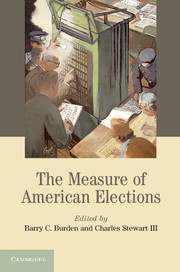Book contents
- Frontmatter
- Contents
- List of figures
- List of tables
- List of contributors
- Acknowledgments
- 1 Introduction to the Measure of American Elections
- 2 Registration and Voting: A View from the Top
- 3 Voter Registration: The Process and Quality of Lists
- 4 Provisional Ballots
- 5 Mail Ballots in the United States: Policy Choice and Administrative Challenges
- 6 Voting from Abroad: Evaluating UOCAVA Voting
- 7 Polling Place Practices and the Voting Experience
- 8 Disability and Election Policies and Practices
- 9 The Performance of Election Machines and the Decline of Residual Votes in the United States
- 10 Voter Confidence as a Metric of Election Performance
- 11 Election Data Transparency
- Appendix
- References
- Index
11 - Election Data Transparency
Published online by Cambridge University Press: 05 August 2014
- Frontmatter
- Contents
- List of figures
- List of tables
- List of contributors
- Acknowledgments
- 1 Introduction to the Measure of American Elections
- 2 Registration and Voting: A View from the Top
- 3 Voter Registration: The Process and Quality of Lists
- 4 Provisional Ballots
- 5 Mail Ballots in the United States: Policy Choice and Administrative Challenges
- 6 Voting from Abroad: Evaluating UOCAVA Voting
- 7 Polling Place Practices and the Voting Experience
- 8 Disability and Election Policies and Practices
- 9 The Performance of Election Machines and the Decline of Residual Votes in the United States
- 10 Voter Confidence as a Metric of Election Performance
- 11 Election Data Transparency
- Appendix
- References
- Index
Summary
Providing useful information to interested parties about the election process is the responsibility of election officials. Useful information is easily accessible and transparent. This implies openness, communication, and accountability. By accessible and transparent, I mean information or data that are relatively easily available and easy to understand. Transparency invites verification. Election officials are responsible for conducting elections in a free and fair manner. To help determine that an election is free and fair, data produced during the election must be made available for independent examination. That information must be transparent.
The concepts of accessibility and transparency focus on the ease and availability of information so that those involved in the election can participate in and evaluate it. These include voters, perhaps the primary client in an election, as well as other stakeholders, including election administrators, policy makers, legislators, policy advocates, election activists, and scholars. For voters, material that assists them in the voting process, including information about the ballot, how to register, if their votes were counted, where to vote, and how to obtain an absentee ballot, are all critical pieces of information. For other stakeholders, information is needed to assess the quality of the election, for example, to determine that the election was legitimate, to verify that the candidate who received the most qualified votes won the election, and to suggest ways in which the process can be improved.
- Type
- Chapter
- Information
- The Measure of American Elections , pp. 271 - 298Publisher: Cambridge University PressPrint publication year: 2014
- 2
- Cited by



